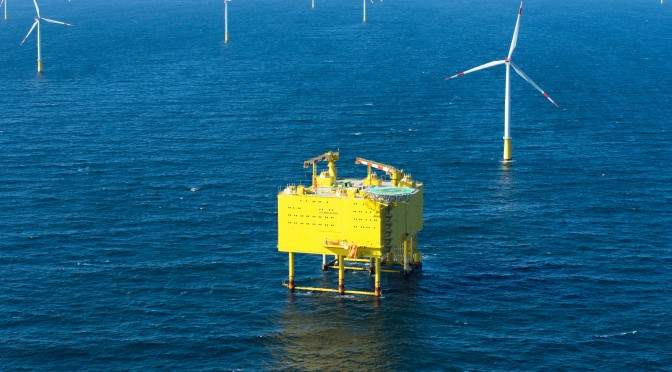Siemens has handed over SylWin1, the third North Sea grid connection this year, to its customer TenneT.
The German-Dutch transmission grid operator has now put the world’s most powerful grid connection to date into commercial operation.
The offshore platform of the SylWin1 grid connection is located around 70 kilometers west of the island of Sylt, after which the project was named.
The electricity generated by wind power is transmitted over a more than 200 km subsea and underground cable link to the land-based station Büttel. Up to 864 megawatts (MW) of green electricity can now be transmitted with this grid connection – enough to supply more than a million German households.
Electricity from the three wind farms Butendiek, DanTysk and Sandbank is transmitted to the mainland via the SylWin1 grid connection. Siemens installed the grid connection in high-efficiency DC technology for network operator TenneT. The combined total of 232 Siemens wind turbines linked to the grid connection will provide enough electricity to supply more than one million households in the future. From the platform, there are wind turbines in view as far as the eye can see.
“This year we have completed the world’s first three offshore grid connections with efficient direct-current technology – SylWin1, BorWin2 and HelWin1. We also intend to put the fourth project HelWin2 into commercial operation as planned in the coming weeks”, stated Jan Mrosik, CEO of the Siemens Energy Management Division. “2015 is a special milestone year for TenneT”, emphasized Lex Hartman, member of the managing board of TenneT TSO GmbH, “as we will be completing further offshore grid connections by the end of the year, meaning that all in all we will have implemented a capacity of more than 5,000 MW, or more than two-thirds of the offshore expansion goal set by the Federal German government by then.” The government’s offshore expansion goal aims at implementing 6,500 MW by 2020.
The three offshore wind farms DanTysk, Butendiek and Sandbank, each with a capacity of 288 MW, are linked to SylWin1. DanTysk and Butendiek both consist of 80 Siemens wind turbines, each rated at 3.6 megawatts. Sandbank will be realized with 72 Siemens wind turbines in the 4-megawatt class. At present, more than 100 wind turbines are already linked to the grid connection, with new turbines being connected almost on a daily basis. Under optimal wind conditions, such as those which the low-pressure storm front Niklas brought with it recently, a capacity of 350 MW was already transmitted via the SylWin1 grid link.
Transmission system operator TenneT contracted the consortium comprising Siemens and the Italian cable specialist Prysmian for the HelWin1 offshore grid connection early in 2011. The offshore platform was built by Nordic Yards in Germany. In total, Siemens has been awarded five North Sea grid connection projects by TenneT: HelWin1 (576 MW) and HelWin2 (690 MW) off of Helgoland, BorWin2 (800 MW) and BorWin3 (900 MW) off of Borkum and SylWin1 (864 MW) off of Sylt. Three of these, BorWin2, HelWin1 and SylWin1, have already taken up normal operation.
The fourth grid connection HelWin2 is scheduled to take up commercial operation in the first half of 2015 as well. Siemens received its latest order for a grid connection in the North Sea, BorWin3, in a consortium with Petrofac in the spring of 2014. Commissioning of this fifth grid connection from Siemens is scheduled for 2019. The grid connections implemented by Siemens for TenneT will have a total transmission capacity of more than 3.8 gigawatts (GW), providing electricity from offshore wind power to supply nearly five million households.
Thanks to the Siemens high-voltage direct-current (HVDC) technology, transmission losses for each grid connection, including cable losses, are less than four percent. This Siemens HVDC technology is installed on the offshore platforms and in the land-based converter stations. The wind-based electricity is transmitted as alternating current to the converter platform, transformed into direct current and fed to the mainland via a subsea cable. The land-based station converts the direct current back into alternating current and feeds the electricity into the extra-high voltage grid. HVDC is the only efficient transmission solution for cable lengths of more than 80 kilometers.
The HVDC Plus technology used by Siemens is less complex and extremely compact, making it predestined for use in sea-based applications. In contrast to classic HVDC technology used in a vast majority of land links, systems equipped with HVDC Plus feature self-stabilization. As fluctuations in the grid must always be reckoned with for wind-based power generation, grid stability and reliability is enhanced considerably through the use of the Siemens HVDC Plus technology.



